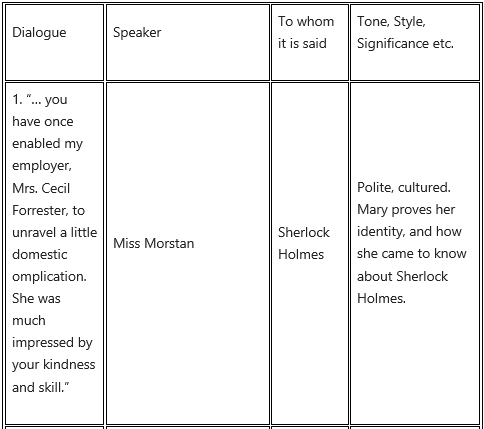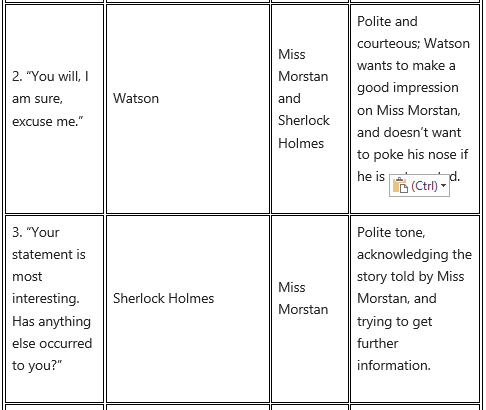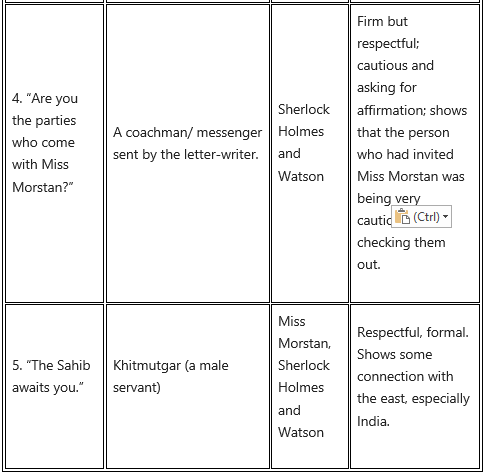Chapter 4.4 The Sign of Four
Chapter 4.4 The Sign of Four
Textbook Questions and Answers
CHARACTER:
(A1)
Question (i)
Read the extract again and complete the web by highlighting the qualities of the following characters:
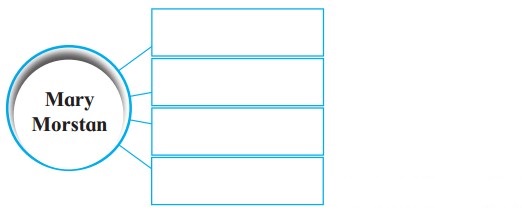
Answer: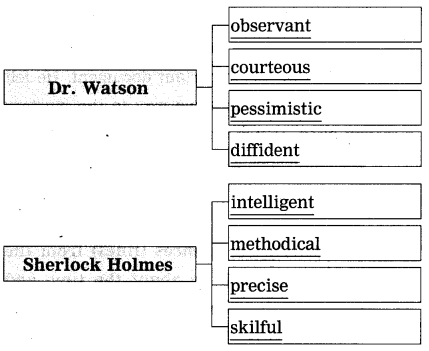
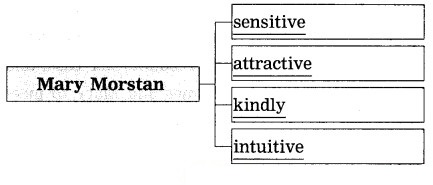
Question (ii)
Describe the character of Mary Morstan from Dr. Watson’s point of view.
Answer:
From Dr. Watson’s point of view: When I first saw Mary, she was dressed simply but tastefully. I could see that she was a person of limited means. Her expression was sweet and pleasant, and I could make out that her nature was refined and sensitive. My calculations told me that she was about 27 years old. She was agitated by the mystery surrounding her life. I found her attractive, though her face did not have regular features or a beautiful complexion. Her eyes showed that she was a sympathetic person. I was much impressed by her and attracted to her.
Question (iii)
Sherlock Holmes is the leading character in the extract. Explain.
Answer:
It is Sherlock Holmes who is the detective and the leading character. Mary Morstan had come to ask his advice about a problem that she was facing. Holmes was the one who took the lead and found out about Major Sholto; it was Holmes who analysed the handwriting in the letter that Mary had received. Holmes was sharp, accurate, intelligent and methodical. He had an excellent record of solving cases, and his deductions were always correct. Watson was merely his friend who helped him and kept a record of his cases.
Question (iv)
Dr. Watson, the narrator, is one of the major characters in the novel. Illustrate.
Answer:
Dr. Watson is the narrator. He was present when the case was brought to Holmes by Mary Morstan. He is generally always with Holmes, helping him to solve cases. He accompanied Holmes whenever necessary.
He also kept a record of all the cases that Holmes was a part of. In this extract, he is present when Mary recounts her case, and he accompanies Holmes and Mary to meet the writer of the anonymous letter. (He marries Mary in the end.)
Question (v)
Holmes is always one step ahead of Dr. Watson in solving cases. Elucidate.
Answer:
Where Watson is emotional, simple and trustful, Holmes is sharp, objective and methodical. Holmes is also analytical and notices the little details which give him clues to solving a case. Watson does not, and hence is often on the wrong track. Holmes is the real detective, while Watson is merely his companion. Holmes is always ahead of Watson and solves cases which Watson is not even near to cracking.
PLOT:
(A2)
Question (i)
Arrange the sentences in correct sequence as per their occurrence in the extract.
Answer:
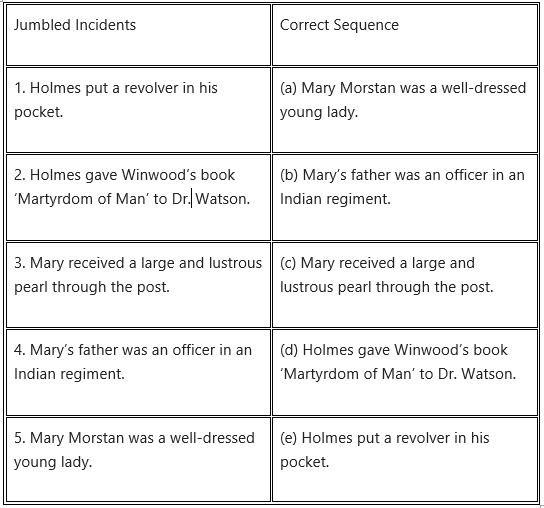
(ii) Discuss the importance of the following statements from the light of the extract.
Question (a)
The trio-Holmes, Dr. Watson and Mary decide to visit Lyceum Theatre.
Answer:
Mary had received an anonymous letter asking her to be outside the Lyceum Theatre on a particular night at seven o’clock. The letter said that it would be to Mary’s advantage if she came. The letter also mentioned that she could bring two friends with her. However, she did not have any friends who could accompany her, and so she asked Holmes and Watson if they could do so. They agreed. Hence, Holmes, Dr. Watson and Mary decide to visit Lyceum Theatre. This was the first step to solving the case.
Question (b)
Mary received pearls every year on the same day.
Answer:
Major Sholto, Mary’s father’s friend, had cheated Mary’s father of his share in the Agra treasure. When he died, Major Sholto informed his son Thaddeus of this. Though Thaddeus did not have the treasure, he tried to rectify the matter to a certain extent by sending Mary a rare and expensive pearl every year, on the same day as he sent the first one.
Question (c)
Holmes carefully examined the paper given by Mary.
Answer:
Mary had found a curious paper in her father’s desk which no one could understand. Holmes deduced from the colour of the paper that it was an important document. He felt it was related in some way to the mystery on hand. Hence, he examined it carefully to get some clues which would help to solve the mystery.
SETTING:
(A3)
Question (i)
Cite various references (lines) from the extract that tell us about the time and period of the events:
Answer:
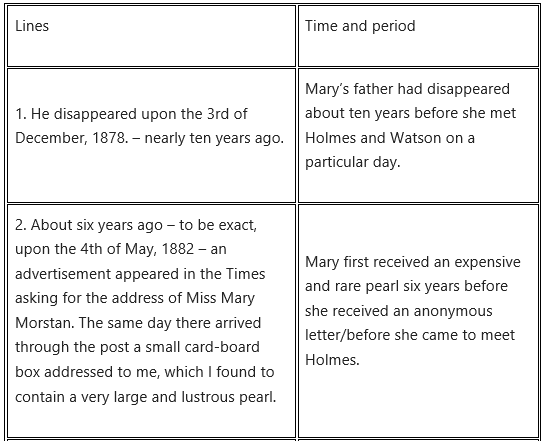
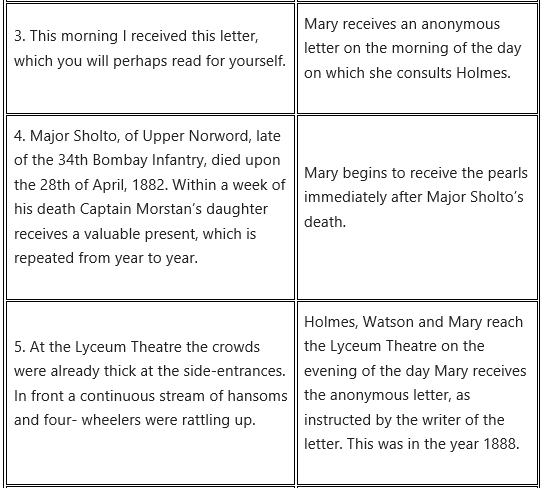

Question (ii)
Explain by citting references from the extract the ways the series of actions moves from London to India.
Answer:
The extract begins when Mary Morstan meets Sherlock Holmes at his house in London. They then meet Thaddeus Sholto in a rundown neighbourhood of London. Thaddeus reveals that his father Major Sholto had mistakenly killed Captain Morstan in London. They then go to Bartholomew Sholto’s house to get the treasure; however, Bartholomew is found dead.
Holmes follows Jonathan Small and Tonga, who have escaped by a steam launch, over the river Thames in London. When Small is captured, he tells them about the time he spent in India, where he was an accomplice in stealing the Agra treasure. Thus, the narration goes to India. Major Sholto and Captain Morstan were also at one time stationed in India.
Question (iii)
The extract begins when Mary Morstan meets Sherlock Holmes at his house. After that Holmes, Dr.Watson and Mary visit some places in London. Explain in detail the various places mentioned in the extract.
Answer:
Holmes, Dr.Watson and Mary were taken down the Strand, which was crowded, badly lit and humid. All kinds of people-sad, happy, old and young could be seen moving about in the dim light. Watson found it eerie and ghostlike, and he felt nervous and depressed. They then reached the Lyceum Theatre, where the crowds were pouring in.
A continuous stream of horse carriages could be seen, with stylish people getting out of them. Near the Lyceum Theatre they were met by a coachman who took them in his coach through Rochester Row and Vincent Square onto Vauxhall Bridge Road. They were on the Surrey side, on the bridge from where they got glimpses of the river Thames with lamps shining on the silent water.
The cab then took them through a maze of streets. Holmes could identify Wordsworth Road, Priory Road, Lark Hall Lane, Stockwell Place, Robert Street and Cold Harbor Lane. They were all rundown places. The cab took them further to a rather grim and shady neighbourhood with dull brick houses and cheap and showy public houses at the corner.
Holmes mentions that this was not a very fashionable or rich neighbourhood. This was followed by rows of two-storied villas each with a small front garden, and then again there were never-ending lines of new brick buildings, which were an extension of the city. The houses in the area were all dark and appeared uninhabited.
At last the cab drew up at the third house in a new terrace, which was also dark except for a light in the kitchen. However, when they knocked the door was opened instantly, and an Oriental figure of a servant clad in a yellow turban, white loose-fitting clothes, and a yellow sash stood there. It was strange to find an Oriental figure framed in the doorway of a cheap suburban house.
Question (iv)
Basically the setting of the extract is in London but it has some references of India, too. Explain how the settings of the extract contribute to the theme of the novel.
Answer:
The setting of the extract is in London, where Mary meets Holmes and Watson to explain her problem. She talks about her father being an officer in an Indian regiment. When he returned to England on leave, he called Mary to meet him at a London hotel, but disappeared mysteriously before she could do so. His only friend in London was a Major Sholto. Holmes finds that Major Sholto was also from the 34th Bombay Infantry.
Mary shows Holmes a piece of paper belonging to her father. The paper was of Indian origin, and three of the names written on it were also Indian. Holmes, Watson and Mary go to meet the anonymous letter writer at a rundown suburban house in London. Later they chase Jonathan Small and Tonga, who were trying to escape by boat on the river Thames. When Jonathan Small was captured, he spoke of being an accomplice in stealing the Agra treasure.
He was sent to the Andaman Islands, where Major Sholto and Captain Morstan were prison guards. At the end of the extract, the door of the anonymous letter writer’s house was opened by an Indian servant. His master used an Indian name to call him. Thus, we have a mingling of incidents both in London as well as in India, where the case had its roots.
Question (v)
Describe in brief the importance of the following places in the extract.
(a) London
(b) Lyceum Theatre
(c) Edinburgh
(d) Agra
(e) Andaman Islands
Answer:
(a) London: The case starts here with Mary Morstan meeting Holmes at his place in London. They go to meet Thaddeus Sholto in London. They also chase Jonathan Small and Tonga in London. Tonga is killed and Small captured. Small then narrates the entire story.
(b) Lyceum Theatre: This is the place near which the writer of the anonymous letter told Mary Morstan to reach if she wished to get justice.
(c) Edinburgh: Mary spent her childhood till she was seventeen at a boarding school in Edinburgh.
(d) Agra: When Jonathan Small was standing guard one night at the Agra fortress, he was overpowered by two Sikh troopers, who forced him to waylay a servant of a Rajah and steal a valuable fortune in pearls and jewels. This was called the ‘Agra treasure’.
(e) Andaman Islands: Jonathan Small was arrested and imprisoned on the Andaman Islands for the robbery of the Agra treasure. After 20 years, Small made a deal with John Sholto and Arthur Morstan, who were the prison guards. Sholto would recover the treasure and in return send a boat to pick up Small and the Sikhs. Sholto double-crossed both Morstan and Small and stole the treasure for himself. Small vowed vengeance and four years later escaped from the Andaman Islands with an islander named Tonga after they both killed a prison guard.
Question (vi)
Complete:
Name the places/cities in India and England which are mentioned/have appeared in the extract. Describe their importance.
Answer:
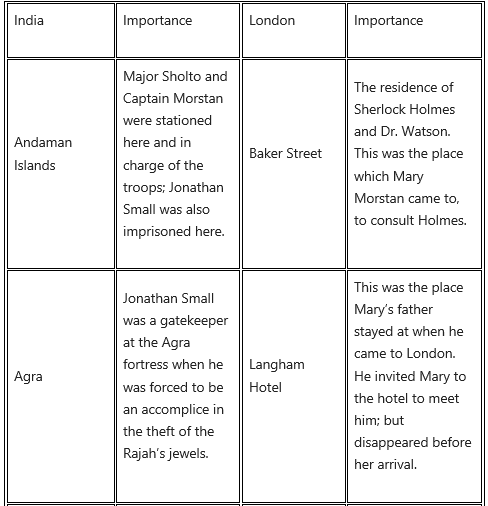
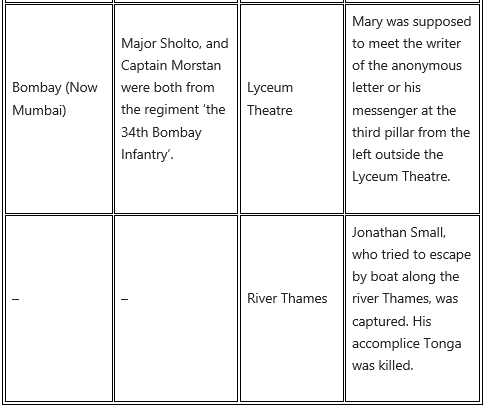
THEME:
(A4)
Question (i)
Write in brief the theme of the extract.
Answer:
The theme of the extract revolves round the mystery of the disappearance of Mary Morstan’s father, the receipt of expensive pearls by Mary and the mysterious letter received by her. It also involves the journey of Holmes, Watson and Mary Morstan to a strange house to meet the writer of the mysterious letter. The theme of the novel revolves around the Agra treasure.
Question (ii)
Write 4-5 sentences about the meeting of Miss Morstan with Holmes.
Answer:
Miss Morstan met Holmes and Watson at their house in Baker Street. She then discussed with them the mysterious disappearance of her father a few years earlier, the receipt of an expensive pearl every year for the past six years, and the receipt of a mysterious letter that morning asking her to meet the writer of the letter. Miss Morstan was intensely agitated and confused and did not know what to do. She showed Holmes the pearls, the boxes in which they had come and the letter. Then they planned to follow the instructions and meet the writer of the letter.
Question (iii)
Write the central idea of the given extract of the novel, “The Sign of Four”.
Answer:
The central idea is the meeting of Mary Morstan with Holmes and Watson, and her explanation of her problems. It is also about the short trip made by the three to meet I the writer of the mysterious letter. This is Watson’s first meeting with Miss Morstan and his attraction towards her.
Question (iv)
Complete the following giving reasons:
Answer:
(a) Miss Morstan plans to meet Sherlock Holmes to ask his advice about the disappearance of her father, the receipt of expensive pearls and the mysterious letter received by her.
(b) Miss Morstan gives the reference of Mrs. Cecil Forrester because Mrs. Cecil Forrester was her employer, whom Holmes had once helped to solve a domestic complication. Mrs. Forrester had been impressed by his kindness and skill.
(c) It’s a singular case because Miss Morstan’s father had come back to England and contacted her, and had seemed happy. After fixing a meeting ; with her at his hotel, he had suddenly ; disappeared and was never seen again, Even his only friend in town, Major Sholto, had not known either of his ; arrival or disappearance.
(d) Holmes needed some references to find out details about Major Sholto, who was the only friend Mary’s father had in England, and who had said that he did not know about his arrival in England.
(e) Miss Morstan received a pearl every year, when she replied to an advertisement asking for her address, adding that it would be to her advantage.
(f) The coachman confirmed that neither of Miss Morstan’s companion was a police officer because this was the condition made by the writer of the mysterious letter, whom they were going to meet.
LANGUAGE:
(A5)
(i) Elaborate the following lines in the light of the novel/extract, “The Sign of Four”:
Question (a)
“You really are an automaton – a calculating machine”.
Answer:
These words are said by Watson to Holmes when Mary Morstan had left after discussing her case. Watson is attracted to her and full of admiration for her. When he voices his admiration, Holmes says that he had not noticed if she is attractive or not. Watson is indignant and calls him a calculating machine.
Question (b)
“The letter speaks of giving her justice.”
Discuss.
Answer:
These are the words of Holmes to Watson, when they are discussing the letter that Mary Morstan has received from an unknown person. He wondered what was the ‘justice’ that the letter spoke of, and who had done ’ something wrong to Mary that she now needed justice.
Question (c)
“Our quest does not appear to take us to very fashionable regions.”
Answer:
These words are said by Holmes to Watson and Mary Morstan, when they are being driven by the coachman to some strange place. They were going through narrow streets in an unfriendly and grim neighbourhood, which had dull brick rows of houses and cheap and showy public houses at the comer. Holmes mentions that this was not a very fashionable or rich neighbourhood.
Question (ii)
Following are some dialogues of the major characters in the extract. Find out who the speaker is, his/her tone, style, significance, etc. of the dialogue.
Answer:
